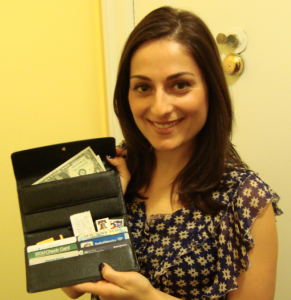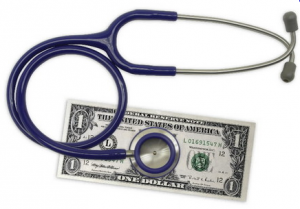Farnoosh Torabi's Blog, page 77
March 30, 2011
Nate Berkus Blog: Credit Scores 101
 This week on TheNateShow.com, learn how to boost your credit score with straight-forward steps. My fiancé and I are shopping around for a home loan at the moment and discovering the power of the almighty credit score – the number between 350 and 800 that banks consider before deciding the terms on your loan. Check out Nate's blog for my full post.
This week on TheNateShow.com, learn how to boost your credit score with straight-forward steps. My fiancé and I are shopping around for a home loan at the moment and discovering the power of the almighty credit score – the number between 350 and 800 that banks consider before deciding the terms on your loan. Check out Nate's blog for my full post.

March 29, 2011
MoneyWatch: Free eBooks!
 On MoneyWatch.com this week, I compiled a list of 9 ways you can download books to your e-reader for free. The first – but probably not most obvious – place to start your search for free downloads is the public library. In fact approximately two-thirds offer access to e-books, up 38 percent from three years ago.
On MoneyWatch.com this week, I compiled a list of 9 ways you can download books to your e-reader for free. The first – but probably not most obvious – place to start your search for free downloads is the public library. In fact approximately two-thirds offer access to e-books, up 38 percent from three years ago.
Recently, though, this trend has been facing headwinds. HarperCollins Publishers has overturned its agreement with libraries, according to The New York Times, saying their digital editions will no longer be available in perpetuity; the library's e-copy can now only be checked out 26 times before expiring, at which point the library has to re-purchase the e-book. There is concern that other publishing houses may follow suit. The new limitations are causing some libraries – which, like the publishers, are grappling with financial constraints – to bypass HarperCollins' e-books altogether.
Amazon Kindle owners, meanwhile, need to look elsewhere anyway. Most libraries use e-book distributor OverDrive, which is compatible with desktops, laptops, iPad and iPhone, Sony eReader and Barnes &Noble's Nook – but not the Kindle.
Fortunately for consumers (and Kindle owners), there are other ways to find free e-books. I'd suggest beginning the search at your local library, since libraries can use all the support we can give – but if you come up dry, consider these 8 alternatives listed in my column on MoneyWatch.

March 28, 2011
Blogging for Nate!
 I'm thrilled and honored to announce my latest collaboration with Nate Berkus and his fantastic team at The Nate Berkus Show. Nate and his producers have asked me to offer a weekly financial column, in addition to visiting the show and helping Nate's guests and viewers achieve financial independence!
I'm thrilled and honored to announce my latest collaboration with Nate Berkus and his fantastic team at The Nate Berkus Show. Nate and his producers have asked me to offer a weekly financial column, in addition to visiting the show and helping Nate's guests and viewers achieve financial independence!
I've already started and my recent post is on the biggest money myths for new parents. A $900 stroller is a need? Really?
Also, make sure to catch the show this Thursday, March 31, when we show you how to turn your passion into a paycheck!

New York Times Paywall Goes Up Today
 The news was inevitable, though still disappointing: Starting today The New York Times will begin charging readers for full access to its Web site, as well as its smartphone and iPhone applications.
The news was inevitable, though still disappointing: Starting today The New York Times will begin charging readers for full access to its Web site, as well as its smartphone and iPhone applications.
The good news is the applications will still be free to download, the Top News section will remain free and readers can view up to 20 others articles for free per month. But after the 20 article limit, you'll need to choose a subscription:
$15 every four weeks for access to the Web site and a mobile phone app
$20 for Web access and an iPad app
$35 for an all-access plan
So what are the best ways to get your online New York Times fix for less?
Check out my blog on CBSMoneyWatch.com for some great tips and calculations.

March 19, 2011
Bride on a Budget: 8 Money-Saving Strategies
 After years of preaching to brides and grooms the importance of saving money on your wedding day, the pressure is now upon me to live up to my words. Since my engagement last fall I've become one of those brides-to-be. I'm consuming more wedding magazines and episodes of Say Yes to the Dress (which is airing on both TLC and OWN now) than I ever deemed possible. I want to create the "perfect" day, but at what price?
After years of preaching to brides and grooms the importance of saving money on your wedding day, the pressure is now upon me to live up to my words. Since my engagement last fall I've become one of those brides-to-be. I'm consuming more wedding magazines and episodes of Say Yes to the Dress (which is airing on both TLC and OWN now) than I ever deemed possible. I want to create the "perfect" day, but at what price?
Well, we know what everyone else is spending. TheKnot.com recently unveiled its 2010 wedding survey and found that one in 5 brides is spending more than $30,000 on their wedding, and 12% of brides are spending more than $40,000.
FoxBusiness.com writer Lauren Covello interviewed me for some money-saving advice in a recent piece called "Lifting the Veil on Wedding Expenses."
Here's more…
INVEST IN WHAT COUNTS. Think back to the last wedding you were at – what do you remember? can you remember the flowers or the wedding favors? Do you remember what the invitation looked like? Probably not. As a bride and groom to be, avoid overspending on items that won't necessarily count in terms of making your wedding memorable. Instead, good music, good company and and food/open bar are what couples and guests both say what really count.
START PLANNING NOW. The more time you give yourself, the more you can shop around and negotiate. If vendors discover you have only a few months until your big day, they'll see that you have a ticking clock and will take advantage of that. It will be harder to ask for discounts.
DITCH THE CAKE. In some cases the cake is included in the cost of catering at $10 to $12 per slice. That's thousands of dollars for flour and sugar. While it's traditional to have a multi-tiered cake, your guests won't think less of your wedding if you, say, go for cupcakes or a dessert bar, instead. Ask the caterer to take out the cost and replace it with a more affordable alternative.
CONSIDER SATURDAY ALTERNATIVES. To save have your wedding on an off-night. Saturday is the hottest night to throw yourwedding - and the most expensive. Book on a Friday or Sunday and save hundreds, if not thousands of dollars. Additionally you can save on decorations if you have a winter wedding around December since churches and reception halls may already be decked with wreaths, white lights and flowers for the holidays.
AVOID THE "W" WORD. Easier said than done. I know. But here's the thing: vendors tack on a big premium just because the occasion happens to be a wedding. Say you need flowers or chairs for an anniversary party or a "special occasion" and I reckon that should help keep prices more reasonable.
DITCH FAVORS. BE CHARITABLE. Instead spending money on wedding favors – trinkets that'll probably get tossed or forgotten about quickly – opt to make a donation to a charity in honor of your guests. Share the news on a small card next to individual table settings but don't worry about including the amount of your donation – that's private. Spend as much you want without breaking the bank. This is where the thought counts a lot more than the dollar amount spent.
DIY INVITATIONS. Save hundreds of dollars on save the dates and invitations by making them on your own. The Martha Stewart Crafts aisle at Michaels is one place to shop. Here are some sites that can help you create and print your own invitations, as well: vistaprint.com andmygatsby.com
SAY YES TO THE DRESS…FOR LESS. J.Crew carries a collection of modestly priced wedding dresses, which have grown in popularity over the years. Believe it or not – a growing number of brides are opting for used gowns. Sites like Preownedweddingdresses.com, BravoBride.com and eBay have huge inventories of used dresses.

March 16, 2011
Today Show: Japan, College Savings and Debt
 This morning on Money 911, Jean Chatzky, Melissa Lee and I answered viewers' questions on the tragedy in Japan – and what that may mean for your investment portfolio, as well as how to find college scholarships and manage debt. The clip is below.
This morning on Money 911, Jean Chatzky, Melissa Lee and I answered viewers' questions on the tragedy in Japan – and what that may mean for your investment portfolio, as well as how to find college scholarships and manage debt. The clip is below.
Visit msnbc.com for breaking news, world news, and news about the economy

March 14, 2011
What's In My Wallet?
 A little while ago the folks at Mint.com asked for a peek inside my wallet. The personal finance website believes – and I totally agree – that, "what you carry in your wallet is just as important to your financial health as your healthiest financial habits." So how do you think I do? Check out the infographic below and let me know what's in YOUR wallet!
A little while ago the folks at Mint.com asked for a peek inside my wallet. The personal finance website believes – and I totally agree – that, "what you carry in your wallet is just as important to your financial health as your healthiest financial habits." So how do you think I do? Check out the infographic below and let me know what's in YOUR wallet!

March 3, 2011
iPad 2: I'm Gonna Wait
 Apple debuted the highly anticipated iPad 2at a private event in San Francisco Tuesday. My fiance and I had this marked on our calendars, as we're debating whether to make the splurge. Neither of us are early tech adopters and wanted to see what the new version – which ships March 11 – had to offer.
Apple debuted the highly anticipated iPad 2at a private event in San Francisco Tuesday. My fiance and I had this marked on our calendars, as we're debating whether to make the splurge. Neither of us are early tech adopters and wanted to see what the new version – which ships March 11 – had to offer.
Here's the news: The iPad 2 got much skinnier, going from 13.4 mm to 8.8mm in thickness. The second-generation tablet also works on the Verizon Wireless 3G network, in addition to AT&T's 3G network. It's got two video cameras (one for face-to-face chatting and one for taking videos), as well as a dual-core A5 processor that Apple CEO Steve Jobs, who presented the latest version, says makes the new iPad "dramatically faster."
That's all well and good. But I'm not going to buy it; instead, I think I'll wait for the next generation. Check out my post on MoneyWatch.com to see three reasons why.

March 2, 2011
TODAY Show: Saving For College & Your Credit Score
 This morning on Money 911, I joined Carmen Wong Ulrich, author of The Cost of Living and David Bach, best-selling author and founder of FinishRich.com to answer your questions related to student loans, buying a house and updating your credit score. (That's our cute Skype caller Mariette who had a question for me about credit scoring.) I also stuck around to answer viewer questions live on the Today Show web site. Sorry I didn't get to everyone's questions, but if you can email me at Farnoosh@farnoosh.tv and I will try my best to send a response.
This morning on Money 911, I joined Carmen Wong Ulrich, author of The Cost of Living and David Bach, best-selling author and founder of FinishRich.com to answer your questions related to student loans, buying a house and updating your credit score. (That's our cute Skype caller Mariette who had a question for me about credit scoring.) I also stuck around to answer viewer questions live on the Today Show web site. Sorry I didn't get to everyone's questions, but if you can email me at Farnoosh@farnoosh.tv and I will try my best to send a response.
Visit msnbc.com for breaking news, world news, and news about the economy

February 24, 2011
Affording Health Care: Tips for Gen Y
 Young adults forgo health insurance far more than anybody else, with approximately thirty percent of those aged 18 to 35 having no health insurance, according to the U.S. Census. Between finishing high school or college and entering the work force, many of us fall through the gap, losing coverage we once received from our parents or schools. Perhaps it's due to the fact that some feel invincible, confident they can bounce back from an ailment after a few doses of Zinc and a packet of Airborne. (I've totally been there).
Young adults forgo health insurance far more than anybody else, with approximately thirty percent of those aged 18 to 35 having no health insurance, according to the U.S. Census. Between finishing high school or college and entering the work force, many of us fall through the gap, losing coverage we once received from our parents or schools. Perhaps it's due to the fact that some feel invincible, confident they can bounce back from an ailment after a few doses of Zinc and a packet of Airborne. (I've totally been there).
More likely, though, the lack of coverage stems from not knowing how to best secure and afford proper health insurance. The process can be complicated – and very expensive.
Some, of course, have it relatively easy. They can obtain health insurance through their employer. But even so, that' s not cheap. According to the Kaiser Family Foundation, the average cost of employer-sponsored premiums for single coverage in 2010 was $421 per month, up 5% from the previous year. For families, the premiums cost $1,147 per month, an increase of 3% from 2009. I'm willing to bet that some who would qualify for this perk are simply opting out due to rising out-of-pocket costs.
Still, health insurance is an absolute need. Medical coverage is just as vital as the roof over your head, the keys to your car and the cash sitting in your bank account. For those who don't believe they need health insurance because of their youth, consider this statistic: One in six young adults has a chronic illness like cancer, diabetes or asthma, according to the U.S. Department of Health and Human Services. And spending just one night in a hospital bed without proper medical insurance will set you back several thousands of dollars. In short, a lack of health insurance cripples both access to proper health benefits and your financial life – a double whammy.
With our country's health care system in a current state of flux we still have the ability to take control of our livelihoods by securing health insurance. For those in the market for a plan, here are some alternative strategies for getting the coverage you need at a price you can afford.
Piggyback on Mom & Dad. Thanks to recent passage the Affordable Care Act, young unmarried adults can now remain on their parents' health insurance plan until age 26. The Department of Health and Human Services (HHS) estimates that about 1.2 million young
adults will elect to stay on a parent's health plan in 2011. The insurance plan will cost an average $3,380 per person enrolled as a dependent this year, based on HHS figures. If you can't pay the full amount yourself, offer to at least split the cost with your parents or offer doing chores or some help in exchange.
Piggyback on Your Partner. Some employer-sponsored health care plans extend coverage to domestic partners. Have your partner check with the human resources department to learn about the qualifications. In practically all cases you need to at least share a residence.
Apply for State's HMO. Generally, the cheapest route is getting coverage through your state' s HMO or Health Maintenance Organization. An HMO costs less than buying coverage directly from a health insurance company as an individual, but there are limitations to HMOs. For example, you may have to go with a general practice doctor tied to the HMO plan.
Join a Union or Local Association. Joining a professional organization, union or alliance – like the Freealancers Union – may offer members group health care benefits. Access to affordable health benefits can end up outweighing the cost of the organization' s annual membership fee.
In Between Jobs? Consider COBRA. When you voluntarily switch jobs or get laid off COBRA, or Consolidated Omnibus Budget Reconciliation Act, lets you stay on your previous employer' s health care plan at the group rate for up to 18 months. Note: It can be pricey, since you have to pay the entire premium cost, a monthly expense their previous employer had once almost entirely picked up, plus a 2% administrative fee.
Work Part-Time in Retail. Retailers like Whole Foods, Trader Joe's, Costco and Starbucks offer health care benefits to part-time workers. That's just 10-15 hours a week. Not a bad investment of your time for access to affordable health insurance.
Enroll in School. Some colleges offer health care benefits to part-time students. Of course you will need to spend money to earn this benefit, but if you were considering a higher degree this may be a great route to satisfy both your academic and health goals. Check with college admissions offices for more information about their health care qualifications.
Barter for Benefits. This may sound unusual, but it's actually a growing trend. According to ITEX Corp., the biggest network of barter exchanges in North America, demand for bartering health care jumped by more than 20 percent between 2007 and 2009. In fact, the company has more than 1,100 physicians who take part in the company's local barter groups.




